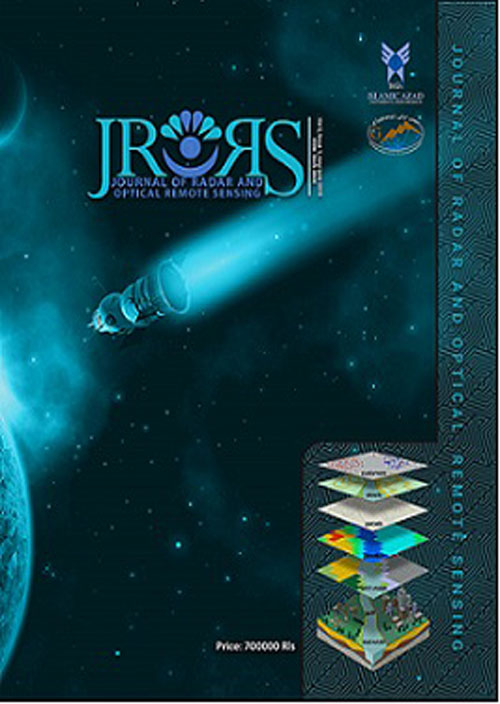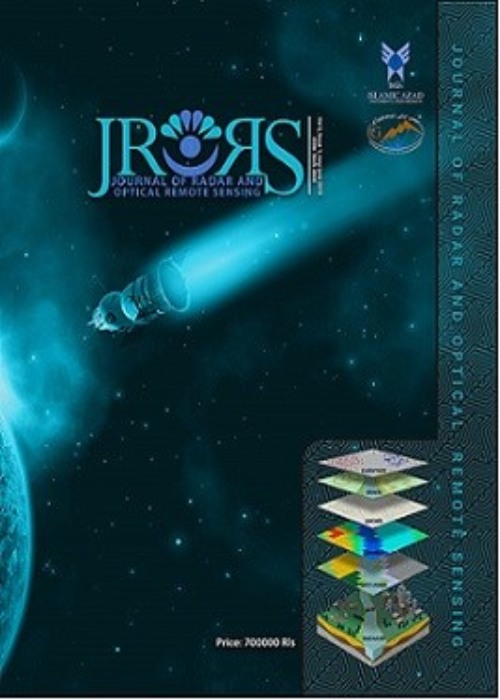فهرست مطالب

Journal of Radar and Optical Remote Sensing
Volume:3 Issue: 2, Spring 2020
- تاریخ انتشار: 1400/05/11
- تعداد عناوین: 6
-
Pages 7-22
The accuracy of retrieved LST from satellites is of great importance. Among different LST validation methods, a cross-calibration procedure is highly cost-effective and applicable. The Indian National Satellite-3D series (INSAT-3D) and Meteosat Second Generation (MSG) are two geostationary satellites that which provide LST products with high temporal resolution. Considering MODIS as the reference (polar orbit that is onboard Aqua and Terra satellites), the comparison of the LST products of these geostationary satellites was evaluated from 4th March to 1st September 2015. For this purpose mean LST ratios were calculated for both MODIS-Imager (from INSAT-D) and MODIS-SEVIRI. Then the behavior of their mean LST ratio was analyzed for the exciting four major land covers and five elevation classes in the study area. The results showed that Imager data underestimated and overestimated the LST in comparison to MODIS data during the day and night time respectively. The SEVIRI LSTs underestimated the LST in both day and night time in comparison with MODIS products. In order to model the discrepancies between MODIS-Imager and MODIS-SEVIRI, for each land cover a multilinear regression model was fitted based on slope, aspect, azimuth, and View Zenith Angle (VZA). The results showed that barren, Shrub, grass, and cereal crops had low RMSEs in model fitting, respectively.
Keywords: LST, Geostationary Satellite, Land cover, Elevation, remote sensing -
Pages 23-30
Rational Function Models (RFMs) are known as the most famous mathematical transformations used in geometric correction of satellite images. Considering the lack of enough and well-distributed Ground Control Points (GCPs), the structure optimization is a critical step in the terrain-dependent RFM estimation strategy. Heretofore, the binary encoding Genetic Algorithm (GA) optimization method has been used to find the optimal structure of RFMs. However, randomized generation of initial population can directly impact the convergence and also computational costs. In this paper, an approach has been proposed to modify the initial population of the GA algorithm based on the correlations of the column vectors of the least square design matrix. In this approach, probability of the presence of each RFM term in the GA initial population is linearly dependent on its correlation with other terms. Although this method slightly decreases the geometric accuracy, it can fall the processing time by 37.02% on average.
Keywords: Correlation of Column Vectors, Genetic Algorithm, Georeferencing, Rational Function Models -
Pages 31-48
The faults and fractures play crucial roles in conducting groundwater flow and providing high recharge zones for aquifers. The hard rock formations are exposed on the ground surface of the west of Yazd Province in Iran and build a reliable groundwater source for consumption. This study aims to provide a hydro-tectonic conceptual model of the region using remote sensing techniques and GIS. The geological map, groundwater resource data, geophysical reports, hydrogeological reports, and Landsat ETM satellite images are collected and evaluated by field visits. The lineaments densities of the area have been extracted and projected on various maps. The results demonstrate that the likelihood of groundwater flow is correlated positively with the region's main geological structures and groundwater resource availability. Finally, to conclude, the hydrotectonics model of the area consists of several distinctive and non-distinctive aquifers because of the presence of hydrogeological and tectonic barriers, water-conducting passages, and even neutral fractures.
Keywords: Faults, groundwater hydrotectonics, Lineaments, remote sensing, Yazd -
Pages 49-59
Many researchers and users have drawn their attention to the radars with Multiple Input-Multiple Output (MIMO) antennas in recent years. The reason is the capabilities that these systems provide to the users, including its low cost, the similarity of the output of MIMO antenna arrays compared to conventional systems with similar characteristics, and its strength. One of the applications of this system in Radar Remote Sensing is identifying the objects and their movement speed. This article’s primary purpose is to identify the moving object and determine its speed by Doppler processing and Fourier transform. For this purpose, firstly general topics related to MIMO systems are mentioned, and then available explanations on how to identify the moving objects are provided. Finally, the characteristics of the sensor used in the laboratory and the results of two different simulations in a software environment are presented. The first simulation is to determine the proper angle of transmission of waves to the object, and the second simulation is to identify two moving objects in two different modes: 1- moving two objects at different speeds while the sensor is stationary and 2- simultaneous movement of two objects and also moving the sensor at different speeds.
Keywords: Multiple Input-Multiple Output RADAR, Low cost, Synthetic Aperture Radar, Phased Array toolbox, Simulation -
Pages 60-71
Radiometric errors are the most common errors of data acquired by remote sensing sensors. Correction of this type of error requires knowledge about the atmospheric conditions during imaging of the sensor. The aim of this study is to select an ideal location for the construction of a radiometric calibration site. Tehran province was selected as a case study to conduct research in a pilot environment. Based on the studies performed on the CEOS standards in site selection as well as the criteria observed in Cal Val sites, 14 parameters were selected as important and necessary parameters for calibration site selection. The data used in this research include two categories of satellite data and GIS layers. After applying the preprocessing on the data and obtaining the weight of each layers, suitable places were obtained for the construction of the calibration site between 2012 to 2019 years. Due to the importance of the consistency of the selected place during different years, the places that were always suitable between the evaluated years, were selected. The results of the research show an ideal location in the western region of Tehran for site construction, which has been selected very well suitable in terms of all criteria. In addition to developing the appropriate location for the calibration site uses, instruments such as san-photometer and goniometer were also developed to be installed on the site to provide services to multispectral and hyperspectral sensors.
Keywords: Radiometric Calibration Site, remote sensing, atmosphere, Tehran -
Pages 72-88
Urban land use maps, in addition to different classes of land use with spatial patterns, specify the type and intensity of land use; therefore, they can be used for current and future planning of urban land. In this study, land use changes in Lali city in 30 years (1987-2017) were investigated. To evaluate the land use changes in this time interval, several spectral images of Landsat satellites 5, 7, and 8 from the years 1987, 2001 and 2017 were utilized. After collecting data and the application of necessary pre-processing on them, also for the preparation of land use maps for the specified time intervals, data analysis was carried out by Maximum Likelihood Classification Algorithm. The findings obtained each year were monitored and controlled through field operations, and land use maps in 7 classes of agriculture, rangeland, forest, mountain, residential, river, and other areas were produced. Then, the changes in each land use were determined in the specified periods during 1987 to 2001, 2001 to 2017, and eventually 1987 to 2017. While the results obtained from the final changes illustrate that the overall level of vegetation compared to the beginning of the period has declined markedly which is an indication of deforestation in the region, urban areas, agriculture, and rangelands have maintained an ascending trend which can be due to increasing urban development and rural expansion, and the growing need of residents for housing, agriculture, and gardens.
Keywords: Lali City, Maximum Likelihood, Algorithm, Land Use


